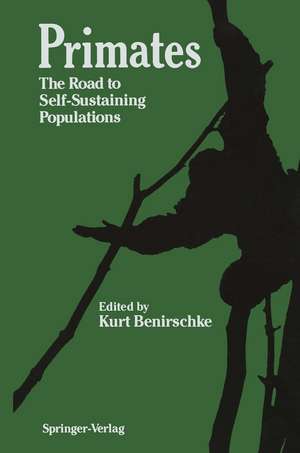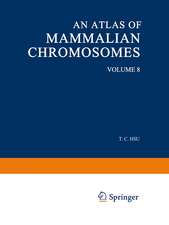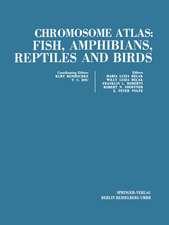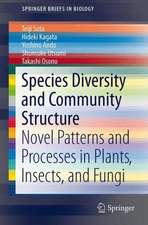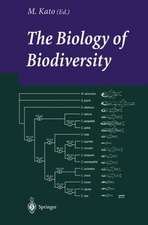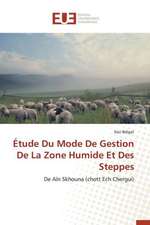Primates: The Road to Self-Sustaining Populations: Proceedings in Life Sciences
Editat de Kurt Benirschke Cuvânt înainte de Jared Diamonden Limba Engleză Paperback – oct 2011
Din seria Proceedings in Life Sciences
- 15%
 Preț: 646.75 lei
Preț: 646.75 lei - 18%
 Preț: 952.26 lei
Preț: 952.26 lei - 15%
 Preț: 637.28 lei
Preț: 637.28 lei - 18%
 Preț: 960.61 lei
Preț: 960.61 lei - 15%
 Preț: 648.24 lei
Preț: 648.24 lei - 15%
 Preț: 632.70 lei
Preț: 632.70 lei - 15%
 Preț: 654.43 lei
Preț: 654.43 lei - 15%
 Preț: 635.80 lei
Preț: 635.80 lei - 18%
 Preț: 959.50 lei
Preț: 959.50 lei - 15%
 Preț: 650.37 lei
Preț: 650.37 lei - 15%
 Preț: 636.45 lei
Preț: 636.45 lei - 15%
 Preț: 644.49 lei
Preț: 644.49 lei - 15%
 Preț: 639.08 lei
Preț: 639.08 lei - 15%
 Preț: 641.53 lei
Preț: 641.53 lei - 15%
 Preț: 664.61 lei
Preț: 664.61 lei - 5%
 Preț: 721.77 lei
Preț: 721.77 lei - 15%
 Preț: 652.49 lei
Preț: 652.49 lei - 5%
 Preț: 718.82 lei
Preț: 718.82 lei - 15%
 Preț: 636.80 lei
Preț: 636.80 lei - 15%
 Preț: 646.43 lei
Preț: 646.43 lei - 15%
 Preț: 649.22 lei
Preț: 649.22 lei - 18%
 Preț: 1390.11 lei
Preț: 1390.11 lei - 18%
 Preț: 956.33 lei
Preț: 956.33 lei - 15%
 Preț: 643.48 lei
Preț: 643.48 lei - 15%
 Preț: 641.38 lei
Preț: 641.38 lei - 15%
 Preț: 642.03 lei
Preț: 642.03 lei - 15%
 Preț: 640.24 lei
Preț: 640.24 lei - 15%
 Preț: 651.34 lei
Preț: 651.34 lei - 15%
 Preț: 649.39 lei
Preț: 649.39 lei - 5%
 Preț: 714.06 lei
Preț: 714.06 lei - 15%
 Preț: 640.37 lei
Preț: 640.37 lei - 15%
 Preț: 664.11 lei
Preț: 664.11 lei -
 Preț: 492.59 lei
Preț: 492.59 lei - 18%
 Preț: 945.47 lei
Preț: 945.47 lei - 15%
 Preț: 647.73 lei
Preț: 647.73 lei - 18%
 Preț: 942.01 lei
Preț: 942.01 lei - 18%
 Preț: 943.57 lei
Preț: 943.57 lei - 15%
 Preț: 639.41 lei
Preț: 639.41 lei - 5%
 Preț: 726.15 lei
Preț: 726.15 lei - 15%
 Preț: 641.03 lei
Preț: 641.03 lei - 5%
 Preț: 707.33 lei
Preț: 707.33 lei - 15%
 Preț: 647.27 lei
Preț: 647.27 lei - 15%
 Preț: 638.57 lei
Preț: 638.57 lei - 15%
 Preț: 645.79 lei
Preț: 645.79 lei - 15%
 Preț: 654.12 lei
Preț: 654.12 lei - 15%
 Preț: 652.31 lei
Preț: 652.31 lei - 18%
 Preț: 946.72 lei
Preț: 946.72 lei - 15%
 Preț: 637.28 lei
Preț: 637.28 lei - 5%
 Preț: 718.46 lei
Preț: 718.46 lei - 15%
 Preț: 653.33 lei
Preț: 653.33 lei
Preț: 678.16 lei
Preț vechi: 797.84 lei
-15% Nou
Puncte Express: 1017
Preț estimativ în valută:
129.76€ • 135.48$ • 107.40£
129.76€ • 135.48$ • 107.40£
Carte tipărită la comandă
Livrare economică 04-18 aprilie
Preluare comenzi: 021 569.72.76
Specificații
ISBN-13: 9781461293606
ISBN-10: 146129360X
Pagini: 1072
Ilustrații: XXIII, 1044 p.
Dimensiuni: 155 x 235 x 56 mm
Greutate: 1.47 kg
Ediția:Softcover reprint of the original 1st ed. 1986
Editura: Springer
Colecția Springer
Seria Proceedings in Life Sciences
Locul publicării:New York, NY, United States
ISBN-10: 146129360X
Pagini: 1072
Ilustrații: XXIII, 1044 p.
Dimensiuni: 155 x 235 x 56 mm
Greutate: 1.47 kg
Ediția:Softcover reprint of the original 1st ed. 1986
Editura: Springer
Colecția Springer
Seria Proceedings in Life Sciences
Locul publicării:New York, NY, United States
Public țintă
ResearchCuprins
1. Primate Ethics.- 2. The Role of Captive Populations in Global Conservation.- 3. African Primate Conservation: General Needs and Specific Priorities.- 4. Gorilla Conservation: Anatomy of a Campaign.- 5. Captive Chimpanzee Populations—Past, Present, and Future.- 6. Responses of Rainforest Primates to Selective Logging in Kibale Forest, Uganda: A Summary Report.- 7. Lemur Survival.- 8. The Conservation Status of Nonhuman Primates in Indonesia.- 9. Southeast Asian Primates.- 10. Conservation of Orangutans: A Status Report, 1985.- 11. The Natural Breeding Strategy of Gibbons (Hylobates lar): Are We Managing the Captive Population by Design or by Default?.- 12. The Primates of India: Status, Trends, and Conservation.- 13. Increased Home Range for a Self-Sustaining Free-Ranging Rhesus Population at Tughlaqabad, India.- 14. Balancing the Wild/Captive Equation—The Case of the Barbary Macaque (Macaca sylvanus L.).- 15. Primate Status and Conservation in China.- 16. Primate Conservation Priorities in the Neotropical Region.- 17. Ecological Background and Conservation Priorities for Woolly Spider Monkeys (Brachyteles arachnoides).- 18. Successes and Failures of Captive Breeding.- 19. History of Geoffroy’s Tamarins, Saguinus geoffroyi, at Lincoln Park Zoological Gardens; 1974–1985.- 20. The Management of Prosimians in Captivity for Conservation and for Research.- 21. Corral Breeding of Nonhuman Primates.- 22. Environments for Captive Propagation of Primates: Interaction of Social and Physical Factors.- 23. Behavior Requirements for Self-Sustaining Primate Populations—Some Theoretical Considerations and a Closer Look at Social Behavior.- 24. Early Socialization.- 25. Behavioral Aspects of Successful Reproduction in Primates.- 26. Conflict Resolution in Monkeys and Apes.-27. Resocialization of Asocial Chimpanzees.- 28. Primate Mating Systems and Their Consequences for Captive Management.- 29. The Interbirth Interval in Primates: Effects of Pregnancy and Nursing.- 30. Embryonic Loss in Primates in Relation to In Vitro Fertilization and Embryo Transfer.- 31. Artificial Acceleration of Reproduction.- 32. Collection, Assessment, and Storage of Sperm.- 33. Artificial Insemination of Nonhuman Primates.- 34. Primate Models for Fertilization and Early Embryogenesis.- 35. Housing and Furniture.- 36. The Howletts Gorilla Bands.- 37. Using Outside Areas for Tropical Primates in the Northern Hemisphere: Callitrichidae, Saimiri, and Gorilla.- 38. Evaluating the Environments of Captive Nonhuman Primates.- 39. Environmental Engineering for Primates.- 40. Research Faculity Breeding.- 41. Research Uses and Projections of Nonhuman Primates as Research Subjects.- 42. Approaches to Determining Colony Infections and Improving Colony Health.- 43. Bacterial Infections of Nonhuman Primates.- 44. Mycotic Infections in Nonhuman Primates.- 45. The Pathoparasitology of Nonhuman Primates: A Review.- 46. Overview of Simian Viruses and Recognized Virus Diseases and Laboratory Support for the Diagnosis of Viral Infections.- 47. Virus-Associated Neoplastic and Immunosuppressive Diseases of Nonhuman Primates.- 48. Viral Diseases of Neonatal and Infant Nonhuman Primates.- 49. Acute Myocarditis in Golden Monkeys.- 50. Rearing and Intensive Care of Neonatal and Infant Nonhuman Primates.- 51. Prenatal and Neonatal Pathology of Captive Nonhuman Primates.- 52. The Effect of Perinatal and Juvenile Mortality on Colony-Born Production at the New England Regional Primate Research Center.- 53. Neoplasms and Proliferative Disorders in Nonhuman Primates.- 54. Scaling and Anesthesiafor Primates.- 55. Nutrition of Primates in Captivity.- 56. The Chinese Golden Monkey—Husbandry and Reproduction.- 57. Captive Status and Genetic Considerations.- 58. Incidence and Consequences of Inbreeding in Three Captive Groups of Rhesus Macaques (Macaca mulatta).- 59. Hereditary Conditions of Nonhuman Primates.- 60. Chromosomal and Molecular Characterization of the Primates: Its Relevance in the Sustaining of Primate Populations.- 61. Considering Subspecies in the Captive Management of Ateles.- 62. Blood Groups of Apes and Monkeys.- 63. The Mind of the Gorilla: Conversation and Conservation.- 64. Translocation of Primates.- 65. Conservation Program for the Golden Lion Tamarin: Captive Research and Management, Ecological Studies, Educational Strategies, and Reintroduction.- 66. Before We Pilot the Ark?.- 67. Who Will Pilot the Ark?.- 68. The Road to the Ark from the Zoo’s Perspective.- 69. Who Will Save the Children?.- 70. The Importance of an Interdisciplinary Approach: Getting the Conservation Act Together.- 71. Recommendations of Workshops.- A. Strategies for the Extremely Endangered Primates.- B. Artificial Breeding.- C. Virus Diseases.- 72. Strategies for the Conservation of Highly Endangered Primates.- 73. Research Needs in Captive Primate Colonies.- 74. Researchable Problems in the Natural Realm.
